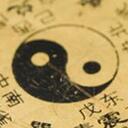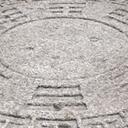The 64 hexagrams of the I Ching are said to have been developed by Duke Wen around 1,200 BC , who was intensively involved with the trigrams of Fu His. He is considered the originator of the short judgments- oracular sayings for each hexagram in the "Book of Changes." His son, the Duke of Zhou , is regarded as the author of explaining the various meanings of the mutable hexagram lines.
Various authors wrote further interpretations and accompanying commentaries over time. Among them were well-known philosophers such as Lao Tse and Confucius . The latter wrote a series of texts with his students and summarised them under "Ten Wings." All commentaries start from the exact names of the individual hexagrams but may differ in their interpretation.
A hexagram consists of two trigrams each. Its meaning derives from the tension between the two trigrams and their different tendencies of movement. The signs always read from bottom to top. Line 1 is at the bottom, line 6 at the top.
In addition, each individual line has a special meaning depending on its position in the hexagram . For example, the lower line symbolizes our present situation, and the upper line shows where the path is leading. In addition, some lines are closely connected. For example, lines 1 and 4 stand for the earth (both are the lower lines of the respective trigram), lines 2 and 5 stand for the human being (these are the middle lines of the respective trigrams), and lines 3 and 6 symbolize the sky (upper lines of the respective trigrams). It is also important that each line be transformed, i.e., can transform into the other line. For example, a Yin line can become a Yang line and vice versa. If there are one or more transformable lines in a personal hexagram, then additional meanings apply, which can be read in the"Book of Transformations ."
The 64 hexagrams
| No. | Name | Picture | |
| 1 | KIEN | The creative | |
| 2 | KUN | The receiving | |
| 3 | JUN | The initial difficulty | |
| 4 | MONG | The youthful foolishness | |
| 5 | SO | The Wait | |
| 6 | SUNG | The quarrel | |
| 7 | SHI | The Army | |
| 8 | BI | The holding together | |
| 9 | SIAU CHU | The taming power of the little one | |
| 10 | LÜ | The Appearance | |
| 11 | TAI | The peace | |
| 12 | PI | The stagnation | |
| 13 | TUNG YEN | Community with people | |
| 14 | DA YU | The possession of greatness | |
| 15 | KIÄN | Modesty | |
| 16 | YÜ | The enthusiasm | |
| 17 | SUI | The succession | |
| 18 | GU | Working on the corrupt | |
| 19 | LIN | The Approach | |
| 20 | GUAN | The contemplation | |
| 21 | SHI HO | Biting through | |
| 22 | BI | The grace | |
| 23 | BO | The fragmentation | |
| 24 | FU | The Return | |
| 25 | WU WANG | Innocence | |
| 26 | DA CHU | The great taming power | |
| 27 | I | The corners of the mouth | |
| 28 | DA GO | Of the great overweight | |
| 29 | KAN | The abysmal | |
| 30 | LI | The adherent | |
| 31 | HIÄN | The influence | |
| 32 | HONG | The duration | |
| 33 | DUN | The retreat | |
| 34 | DA JUANG | The great power | |
| 35 | DSIN | The progress | |
| 36 | MING I | The eclipse of light | |
| 37 | GIA YEN | The clan | |
| 38 | KUI | The Contradiction | |
| 39 | GIÄN | The obstacle | |
| 40 | HIÄ | The Liberation | |
| 41 | SUN | The reduction | |
| 42 | I | The increase | |
| 43 | GUAI | The breakthrough | |
| 44 | GOU | The concession | |
| 45 | TSUI | The collection | |
| 46 | SHONG | The uprising | |
| 47 | KUN | The Affliction | |
| 48 | DSING | The Well | |
| 49 | GO | The upheaval | |
| 50 | DING | The crucible | |
| 51 | JEN | The Exciting | |
| 52 | GEN | The stillness | |
| 53 | DSIÄN | The development | |
| 54 | GUI ME | The marrying girl | |
| 55 | FONG | The Fullness | |
| 56 | LÜ | The Wanderer | |
| 57 | SUN | The Gentle | |
| 58 | DUI | The cheerful | |
| 59 | HUAN | The resolution | |
| 60 | DSIÄ | The restriction | |
| 61 | JUNG FU | Inner Truth | |
| 62 | SIAU GO | Of the small overweight | |
| 63 | GI DSI | After completion | |
| 64 | WE DSI | Before completion |





